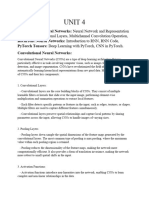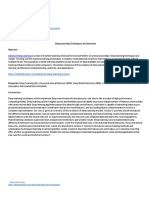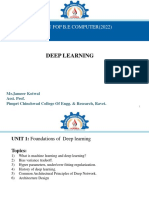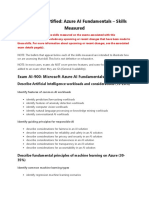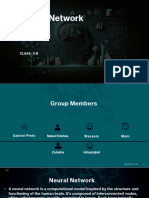Deep Learning
Deep Learning
Uploaded by
Yash GargCopyright:
Available Formats
Deep Learning
Deep Learning
Uploaded by
Yash GargCopyright
Available Formats
Share this document
Did you find this document useful?
Is this content inappropriate?
Copyright:
Available Formats
Deep Learning
Deep Learning
Uploaded by
Yash GargCopyright:
Available Formats
Deep learning is a subset of machine learning that focuses on neural networks with multiple layers,
also known as deep neural networks. These networks, often referred to as deep neural networks or
simply deep learning models, are capable of learning and representing complex hierarchical patterns
and features from data. The term "deep" comes from the depth of the network, indicating the
presence of multiple layers.
Here are some key concepts and components related to deep learning:
1. **Neural Networks:** At the core of deep learning are artificial neural networks, which are
inspired by the structure and functioning of the human brain. These networks consist of layers of
interconnected nodes (neurons) that process and transform input data to produce output.
2. **Deep Neural Networks (DNNs):** These are neural networks with multiple hidden layers,
allowing them to learn intricate patterns and representations in data. The depth of the network
contributes to its ability to automatically extract hierarchical features.
3. **Training:** Deep learning models learn from data through a training process. During training,
the model adjusts its weights and biases based on the input data and corresponding desired outputs.
This process is often done using optimization algorithms and backpropagation.
4. **Activation Functions:** Non-linear activation functions, such as ReLU (Rectified Linear Unit), are
applied to introduce non-linearity into the model. This enables the network to learn and represent
more complex relationships in the data.
5. **Loss Function:** Deep learning models are trained to minimize a loss function, which measures
the difference between the predicted outputs and the actual targets. Common loss functions include
mean squared error for regression tasks and categorical cross-entropy for classification tasks.
6. **Transfer Learning:** Deep learning models can benefit from pre-trained models on large
datasets. Transfer learning involves using a pre-trained model as a starting point for a new task,
which is especially useful when dealing with limited labeled data.
7. **Applications:** Deep learning has achieved remarkable success in various applications,
including image and speech recognition, natural language processing, autonomous vehicles,
healthcare, and many others.
Deep learning has become a powerful tool in artificial intelligence (AI) and has significantly advanced
the state of the art in several domains. It continues to be an active and rapidly evolving field of
research and application.
You might also like
- AI Technical Book (3161608)Document351 pagesAI Technical Book (3161608)Radha Rami100% (10)
- Deep LearningDocument243 pagesDeep LearningMani VasamsettyNo ratings yet
- DL and Feature LearningDocument2 pagesDL and Feature Learningresearchmail505No ratings yet
- Unit 2Document64 pagesUnit 2dengduchupaaNo ratings yet
- DLDocument4 pagesDLakhileswar.21bce9783No ratings yet
- DEEP LEARNING NOTES - BtechDocument26 pagesDEEP LEARNING NOTES - BtechJAHNAVI TULLURU 21BCE7037No ratings yet
- Deep LearningDocument18 pagesDeep LearningMd Mahfooz AlamNo ratings yet
- R21 - A7709 - Deep Learning: Dr. Bhawani Sankar PanigrahiDocument92 pagesR21 - A7709 - Deep Learning: Dr. Bhawani Sankar Panigrahikiranmudhiraj1074No ratings yet
- Deep Learning ProjectDocument24 pagesDeep Learning Projectsherbo.msmNo ratings yet
- Salman Technical SeminarDocument24 pagesSalman Technical SeminarshailajabaspallyNo ratings yet
- DeepLearningLabDocument11 pagesDeepLearningLabVenky kolluNo ratings yet
- Deep Learning NotesDocument71 pagesDeep Learning NotesbarakNo ratings yet
- Deep LearningDocument5 pagesDeep LearningNKOEBE KHOELINo ratings yet
- DLunit 4Document16 pagesDLunit 4EXAMCELL - H4No ratings yet
- Obsolescence in AIDocument5 pagesObsolescence in AIjmgf.2024No ratings yet
- Deep LearningDocument7 pagesDeep Learningdeysoham16No ratings yet
- Unit 3Document21 pagesUnit 3GunaNo ratings yet
- Deep Learning Review and Discussion of Its Future PDFDocument7 pagesDeep Learning Review and Discussion of Its Future PDFeswarannihilNo ratings yet
- UNIT I part 1 notesDocument28 pagesUNIT I part 1 notesRuchita MaaranNo ratings yet
- Deep LearnigDocument16 pagesDeep Learnigsuneel sekharNo ratings yet
- Bone Fracture DetectionDocument26 pagesBone Fracture Detectionteswart2002No ratings yet
- Deep LearningDocument5 pagesDeep Learninglidew58408No ratings yet
- DL MidDocument7 pagesDL MidMohan AbhijeethNo ratings yet
- Machine LearningDocument2 pagesMachine Learningrashmi.prabhaNo ratings yet
- Assignment of Cs 5 SemDocument4 pagesAssignment of Cs 5 Semm54mohtashimNo ratings yet
- Review of Deep Learning Algorithms and ArchitecturDocument29 pagesReview of Deep Learning Algorithms and ArchitecturShuvo H AhmedNo ratings yet
- Deep LearningDocument8 pagesDeep Learninganiketnar8No ratings yet
- AiDocument6 pagesAiza1912129No ratings yet
- Information Management AssignmentDocument33 pagesInformation Management Assignmentjbleander2021No ratings yet
- 3rd Unit DL Final Class NotesDocument78 pages3rd Unit DL Final Class NotesdrmadancseNo ratings yet
- Deep Learning Review and Discussion of Its FutureDocument7 pagesDeep Learning Review and Discussion of Its FutureairsrchNo ratings yet
- Deep LearnongDocument14 pagesDeep LearnongJuniper2015No ratings yet
- Deep Learning IntroductionDocument14 pagesDeep Learning Introductionsmita prajapatiNo ratings yet
- Introduction To Neural Networks and Deep LearningDocument2 pagesIntroduction To Neural Networks and Deep LearningnivedithaNo ratings yet
- 4.1 Overview: Deep LearningDocument11 pages4.1 Overview: Deep Learninggarganand1225No ratings yet
- Unit 1 QP AnsDocument30 pagesUnit 1 QP AnsMd. SunmunNo ratings yet
- Ahishek fileDocument6 pagesAhishek fileAditya sharmaNo ratings yet
- Advance Deep LearningDocument10 pagesAdvance Deep LearningAlia KhanNo ratings yet
- The Fundamental Concepts Behind Deep LearningDocument22 pagesThe Fundamental Concepts Behind Deep LearningAbu RayhanNo ratings yet
- Deep Learning NotesDocument7 pagesDeep Learning Notesbatmanalive3000No ratings yet
- Introduction To Deep Learning - ClassDocument20 pagesIntroduction To Deep Learning - Classs2112287No ratings yet
- 1 - Deep Learning 10-10-2023Document30 pages1 - Deep Learning 10-10-2023Mahmoud hisham AlghnamNo ratings yet
- (Readings) Deep Learning Applications in Business ActivitiesDocument6 pages(Readings) Deep Learning Applications in Business ActivitiesJhoy CastroNo ratings yet
- sodapdf-converted (2) (1)Document6 pagessodapdf-converted (2) (1)Aditya sharmaNo ratings yet
- Abhi PresentationDocument20 pagesAbhi PresentationChella venkannababuNo ratings yet
- Deep Learning As A Frontier of Machine Learning ADocument10 pagesDeep Learning As A Frontier of Machine Learning ARafi Y.SNo ratings yet
- Components-Algorithms/: The Basic Architecture of Neural Networks: Single Computational LayerDocument65 pagesComponents-Algorithms/: The Basic Architecture of Neural Networks: Single Computational Layerafiyaparveen786No ratings yet
- Data Science – Neural Networks, Deep Learning, LLMs and Power BIFrom EverandData Science – Neural Networks, Deep Learning, LLMs and Power BINo ratings yet
- Unit-4 ML Notes Part-2Document21 pagesUnit-4 ML Notes Part-2Prateek SaxenaNo ratings yet
- Unit 5Document39 pagesUnit 5Bhavani GNo ratings yet
- Role of Machine Learning in MISDocument4 pagesRole of Machine Learning in MISMUNEEBA GULNo ratings yet
- Deep Learning As A Frontier of Machine Learning ADocument10 pagesDeep Learning As A Frontier of Machine Learning AAvinash KattaNo ratings yet
- Madda Walabu University: Collage of Computing Department of Information SystemDocument22 pagesMadda Walabu University: Collage of Computing Department of Information SystemLenchoNo ratings yet
- Unit 3Document12 pagesUnit 3maneshareddyaare6300No ratings yet
- Deep Learning NotesDocument13 pagesDeep Learning NotesdatasciencetrainingnucotNo ratings yet
- Unit 1 part 1Document61 pagesUnit 1 part 1storytimess111No ratings yet
- DOC-20241117-WA0000Document52 pagesDOC-20241117-WA0000Jesus IncorporationNo ratings yet
- DL - Unit - 1 - Foundations of Deep LearningDocument35 pagesDL - Unit - 1 - Foundations of Deep LearningRamNo ratings yet
- Main DatasetDocument300 pagesMain DatasetViit PuneNo ratings yet
- UNIT-1 Foundations of Deep LearningDocument51 pagesUNIT-1 Foundations of Deep Learningbhavana100% (1)
- Deep LearningDocument5 pagesDeep LearningNikyleNo ratings yet
- Downloaded From: Https://ray - Yorksj.ac - Uk/id/eprint/9863/: Institutional Repository Policy StatementDocument18 pagesDownloaded From: Https://ray - Yorksj.ac - Uk/id/eprint/9863/: Institutional Repository Policy StatementdiegobonessoNo ratings yet
- Artificial Intelligence Projects PDFDocument4 pagesArtificial Intelligence Projects PDFnasi takeoffNo ratings yet
- Paper 5Document13 pagesPaper 5ahmedalhaswehNo ratings yet
- Future of Media and JournalismDocument47 pagesFuture of Media and Journalismsaraalraei25No ratings yet
- Review On Solar Power System With Artificial IntelligenceDocument4 pagesReview On Solar Power System With Artificial IntelligenceEditor IJTSRDNo ratings yet
- UNIT 1 SADDAMDocument129 pagesUNIT 1 SADDAMSrinivas KanakalaNo ratings yet
- Chat GPTDocument6 pagesChat GPTTarang SinghNo ratings yet
- Diptic Informatiu Mai en BRDocument3 pagesDiptic Informatiu Mai en BRAJota MMNo ratings yet
- SCT Revised QBDocument3 pagesSCT Revised QBhijaNo ratings yet
- AI AssociateDocument11 pagesAI AssociateadambasharihanathNo ratings yet
- Ai 5Document15 pagesAi 5sunilstha68No ratings yet
- Introduction To Generative AIDocument22 pagesIntroduction To Generative AISwapnil PandeyNo ratings yet
- Microsoft Certified: Azure AI Fundamentals - Skills MeasuredDocument3 pagesMicrosoft Certified: Azure AI Fundamentals - Skills Measuredpelloanderson2014No ratings yet
- 1 s2.0 S0007681322000222 MainDocument13 pages1 s2.0 S0007681322000222 Mainsoreta.majthoub235No ratings yet
- Artificial Intelligence "Search": Lecture NoteDocument22 pagesArtificial Intelligence "Search": Lecture NoterickNo ratings yet
- 2021 Artificial Intelligence in HypertensionDocument19 pages2021 Artificial Intelligence in Hypertensionbazot33No ratings yet
- Can LNNs Replace TransformersDocument4 pagesCan LNNs Replace TransformersKatarzyna ZiębaNo ratings yet
- (M2-GUIDE) Pre-Reading The Text-1Document4 pages(M2-GUIDE) Pre-Reading The Text-1Artus ArtigasNo ratings yet
- Artificial Intelligence Thesis TopicsDocument7 pagesArtificial Intelligence Thesis Topicstgpazszid100% (2)
- Ai PresentationDocument9 pagesAi Presentationwaseemrafeeque123No ratings yet
- Hybrid SystemsDocument5 pagesHybrid Systemsjyoti singhNo ratings yet
- Chapter Three: Artificial Intelligence (Ai)Document39 pagesChapter Three: Artificial Intelligence (Ai)mahammed100% (2)
- Gen AI Course ContentDocument6 pagesGen AI Course ContentVipulNo ratings yet
- DL ProjectsDocument3 pagesDL Projectsbakrabu786No ratings yet
- Introduction To Artificial Intelligence (AI) PDFDocument76 pagesIntroduction To Artificial Intelligence (AI) PDFmostapha.hamdaouiNo ratings yet
- AI You Tube PagesDocument156 pagesAI You Tube PagesTapu HassanNo ratings yet
- Syllabi - Cognitive AnalyticsDocument4 pagesSyllabi - Cognitive AnalyticsRAHUL DHANOLANo ratings yet
- Chapter 1 - Introduction To AI CLASS 9Document15 pagesChapter 1 - Introduction To AI CLASS 9Emiya susan JobyNo ratings yet
- Unit 3Document14 pagesUnit 3Riya jainNo ratings yet













